How Rival Gardens of Eden in Iraq Survived ISIS, Dwindling Tourists, And Each Other
Against all odds, Iraq’s religious tourism infrastructure has endured.
A bird flies out of a Lalish temple that features a stone black snake on its wall. (Photo: Erin Trieb)

Thirty-five miles north of Mosul, Iraq, about an hour’s drive from Islamic State territory, was the Garden of Eden. I stood with my interpreter, Salar, a local Iraqi journalist. “See that smoke between the mountains,” Salar said, pointing in the distance. “It’s an oil fire.” The thick plume of smoke marked the entrance to the site. Flames burst from a pipe stuck deep in the earth beneath which lay 25 billion barrels of crude oil worth more than $1 trillion. “These oil explorers think about holy places,” he said. “The more oil, the holier the land.”
But this isn’t the only Garden of Eden. It’s not even the only Garden of Eden in Iraq’s Nineveh plains, the war-torn province through which I was traveling. According to coordinates rather confusingly supplied by the Book of Genesis, the garden was at the spot where one river split into four. Here’s Genesis 2.8-2.14:
Now the Lord God had planted a garden in the east, in Eden; and there he put the man he had formed…A river watering the garden flowed from Eden; from there it was separated into four headwaters. The name of the first is the Pishon; it winds through the entire land of Havilah, where there is gold. The name of the second river is the Gihon; it winds through the entire land of Cush. The name of the third river is the Tigris; it runs along the east side of Ashur. And the fourth river is the Euphrates.
The thinking was, if you can pinpoint the four rivers—Pishon, Gihon, Tigris and Euphrates—you can pinpoint paradise. The Tigris and Euphrates run from northern Iraq the length of the country before meeting in the south. No one knows for sure the location of the Pishon or Gihon rivers, except that they are in Havilah, and no one knows where Havilah is either. These are the two unknown rivers of paradise. Genesis refers to the land of Cush, thought to be Ethiopia, but the known rivers are not near Ethiopia. Others believe the rivers are in Azerbaijan, or point out that Jerusalem is home to the ancient Gihon Spring.
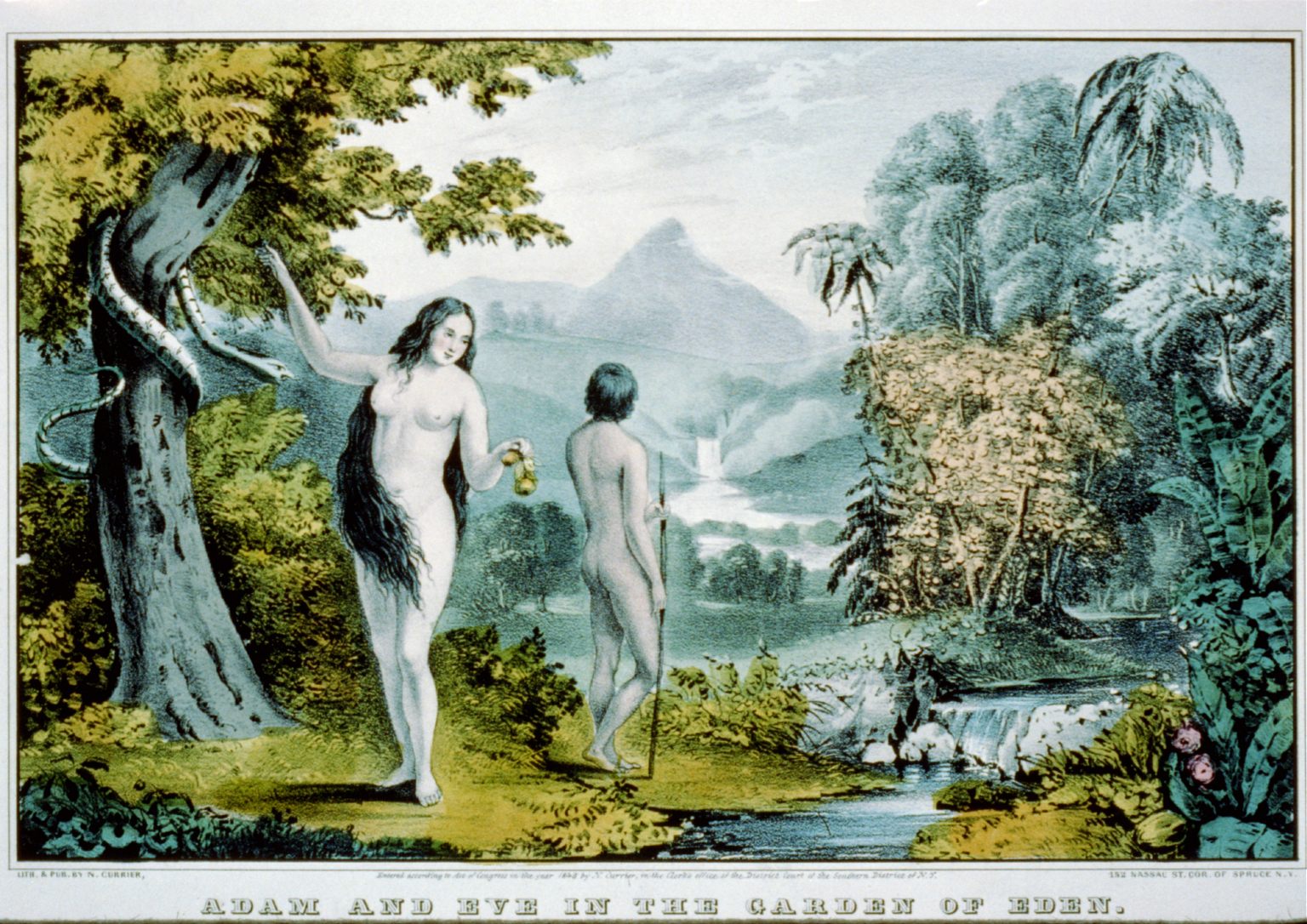
A mid-19th century lithograph of the lushly-landscaped Garden of Eden. (Photo: Library of Congress/ LC-USZC2-1915)
But the exact spot is contested. Believers have alternately placed the garden in Armenia, in the Zagros Mountains of Iran, and in Bahrain, where a lonely tree known as the Tree of Life grows by itself in a waterless desert. A Boston University president named William F. Warren claimed the location for Eden was at the North Pole. Christopher Columbus believed he had found it in Venezuela. In the book The Garden of Eden and the Flood, from 1900, J. C. Keener attempted to prove that the garden was situated in Charleston, South Carolina. Others contended it was in Somaliland near the Horn of Africa. Some thought it was submerged beneath the waters of the Persian Gulf. Dante believed Eden to have been a mountain on an island, without telling us which or where, except that it’s the place where he reunited with his love Beatrice.
The seekers of Pishon and Gihon date back at least as far as the Jewish historian Josephus, who in the 1st century A.D., when Christianity was first taking root in Iraq, associated the Garden of Eden with South Asia, writing, “a river runs toward India and falls into the sea, called by the Greeks the Ganges.” Josephus thought the Pishon the Ganges and the Gihon the Nile. Saint Augustine, the Church Father and bishop of Hippo, spent a great deal of time before his death considering the imaginary nature of Eden. In the Middle Ages, Eden was cherished as a real place on Earth, if only it could be found. The idea was abandoned once explorers made their way around the globe. There was no place for Eden on the modern map.

A photograph of one of the alleged locations of the Garden of Eden, over the Euphrates River. (Photo: Library of Congress/LC-USZ62-92656)
Even those who concede the mythological nature of the Garden of Eden still have the desire to locate it, as I did last May while driving to the frontline in northern Iraq. The mythologies of Christianity, Yazidism, and Islam crisscross the landscape, and I passed through two purported Edens in northern Iraq while a much larger Eden was being resurrected in the south, near Basra, at the meeting point of the Tigris and Euphrates. With one Eden, I learned of another. The stories of Eden multiplied endlessly. Each site wanted to own the Biblical narrative and the few tourists that managed to make their way there.
According to the Bible, God placed a flaming sword at the east side of the Garden so that no human could return to the earthly paradise from which he had cast out Adam and Eve. On the drive that day with Salar, the oil fire visible between two mountains, marked the Garden as designated by the Yazidis, a religious and ethnic minority little known outside the region until its persecution at the hands of the Islamic State.

A map of Iraqi sites claiming to be the Garden of Eden. (Design: Blake Olmstead)
Refugee Eden
The Yazidis’ Garden was at Lalish, a sprawling sanctuary in a lush valley. The valley runs east to west, as does the temple. Lalish is thought to be the place where Sheikh Adi ibn Musafir, the man who established the main rules of Yazidism, retired with his disciples. After his death in 1162, the sanctuary grew up around his tomb and became a center of worship.
Here, Salar and I met our Garden of Eden tour guide, Luqman Mahood, who had a black mustache and wore a small turban high on his head like the shell of a hermit crab. He had gathered us from the scorching parking lot, escorted us past the armed guard in a wood shack, and brought us under the shade of a tree. He said he wouldn’t let us wander alone without his services but he was free of charge. “I’m a Muslim,” he said. “I speak every language, don’t worry about me, Turkish, Arabic, Kurdish, English.” He was barefoot and wore a brown jumpsuit tied tight around the waist. His mustache curled on the ends. He worked for a website run by the Lalish Media Network, a news site which also has a tourism component.
He told us the rules: You cannot wear shoes in the Garden of Eden and you cannot step in the places where the gods sit. You may eat chips from the snack shack but you cannot throw the bags on the ground. Use the designated wastebaskets. You may not venture deep into the secret tunnels beneath the earth but you may visit the public tunnels. We handed our shoes over to the owner of the snack shop. It was crowded with children and the ground strewn with trash. We stepped barefoot into the garden.
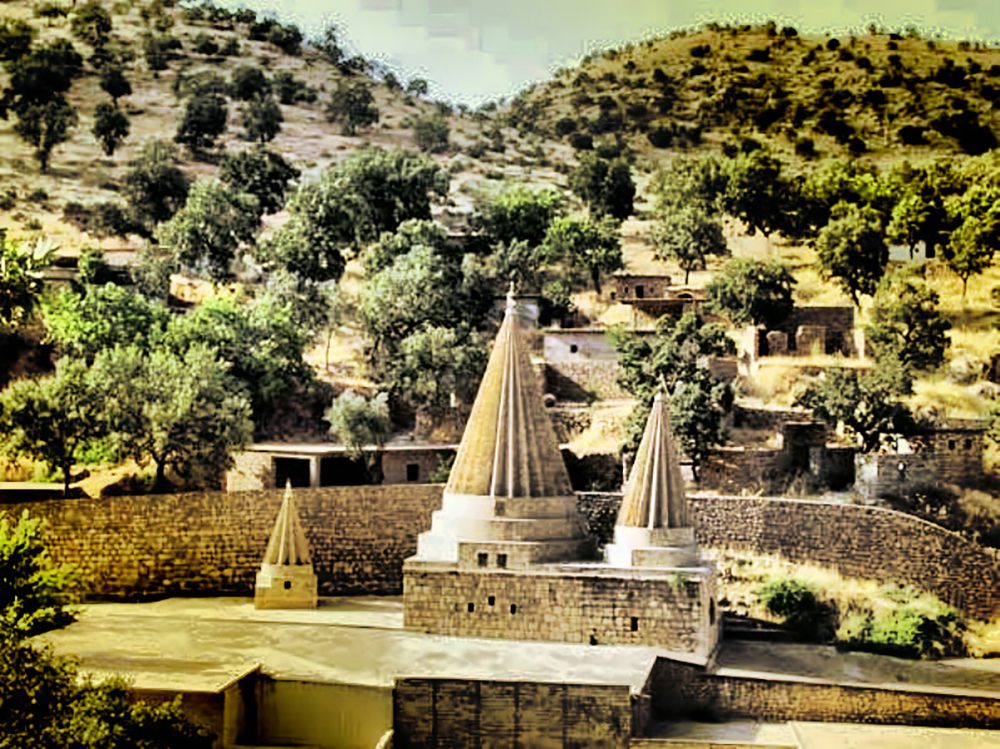
Lalish. (Photo: jan Sefti/CC BY-SA 2.0)
Lalish is a sprawling complex of shrines and mausoleums with no center. Vegetation curled around massive stone structures, and spring water pooled in underground caves. The Yazidis burned oil wicks around conical shrines that rose from the earth like stalagmites. Once a year, they light 365 candles, fueled by olive oil, to bring peace to the world. The flames had scorched the temple walls and black marks were everywhere. There was a room for religious men, a room for pilgrims, and the room of the holy bread.
In the hills, red poppies grew, Mahood said, from the blood of martyrs. The Yazidis set the poppies in the water they used to wash their hands and faces so that gods would recognize them.
We entered a cobblestone courtyard filled with mulberry trees believed to cure diseases. A tree flowered from the tomb of a saint. At the far end of the courtyard, we passed through a semicircular archway. The doorsteps were sprinkled with paper bank notes, Iraqi dinars for the fallen angel. Above it was a carving of two peacocks, and at their feet, two small lions.
The Yazidis kissed and touched a stone that spouted holy water. They believed the stone was a physical manifestation of the peacock angel. “And this,” he said, pointing to a symbol carved in the stone. “This represents the sun that becomes like a ring that covers four sides of the world, and this is Iraq and we believe angels are living here.”
“The Earth was all Yazidi in the beginning,” Mahood told us.
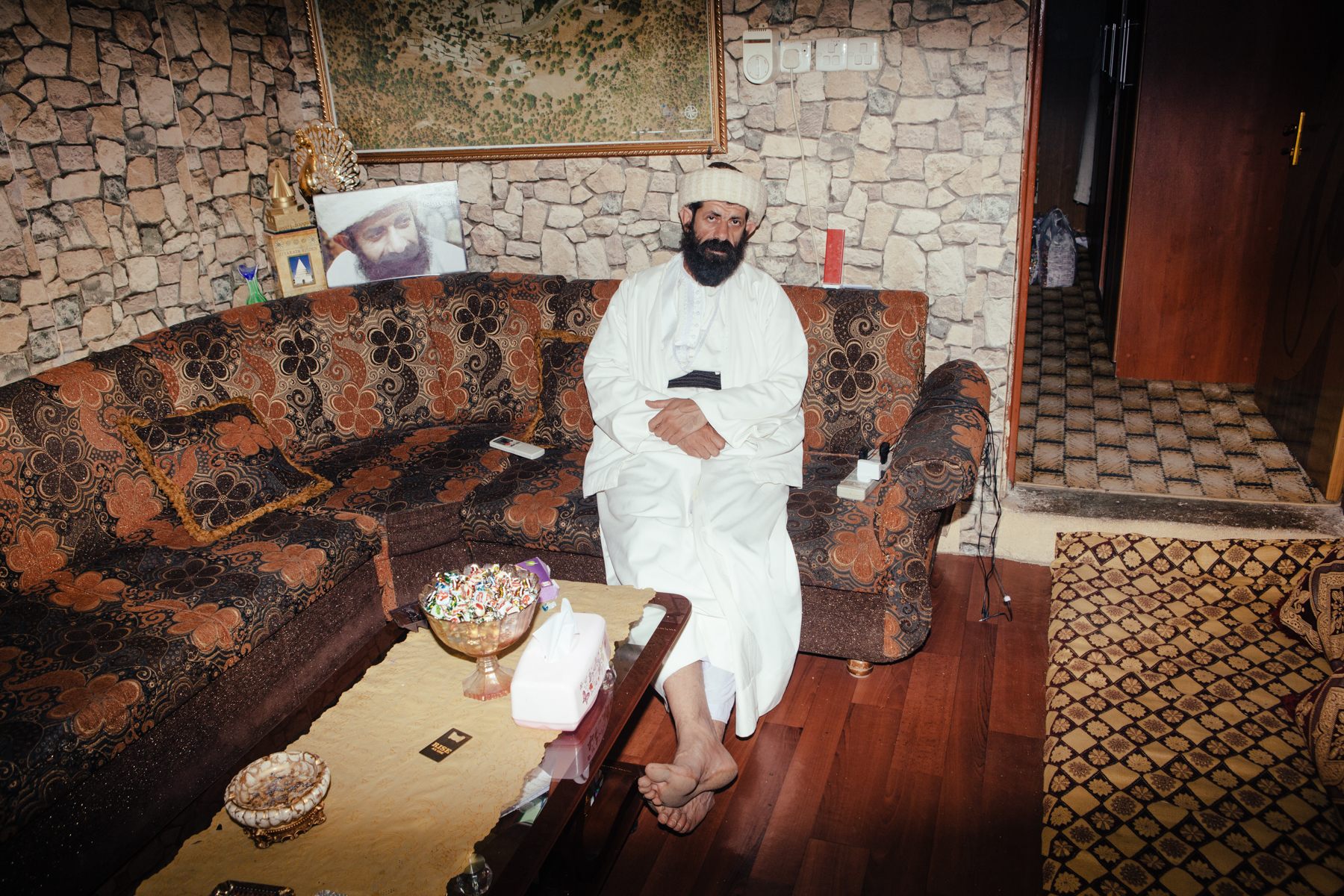
Baba Cawis, a Yazidi high priest, sits in his living room in Lalish. (Photo: Erin Trieb)
The Yazidi faith is neither Christian nor Muslim, but contains elements familiar to both. Thousands of years ago God told one of his seven angels to visit Earth and stop its shaking. It was God’s fault. He’d been playing with a white pearl and when he tossed it into space, it broke, and shattered to form the planets and stars. The angel he chose was named Taus Melek, and on his way down to Earth he disguised himself as a giant peacock. The Earth he found was terribly ugly and filled with dreadful things like volcanoes and earthquakes. He began his work in in Iraq, letting his feathers color the world with plants and animals. But the peacock took advantage of his powers and tried to create his own kingdom at Lalish. God banished him to hell. But he cried for so long–so many thousands of years–that God forgave him.
Melek wandered until he met Adam, the first human. Adam didn’t have a soul. Melek breathed life into him. Eve came into being. Before Adam and Eve reproduced, they attempted to bear children alone. They incubated their seeds in jars and when it was time to look, Eve’s jar was full of insects and rodents, but in Adam’s jar was a beautiful boy. This boy, called Shehid bin Jer or Son of Jar, grew up in the Garden of Eden and his descendants became the Yazidis.
The Yazidis believe Melek will come back to Earth as a peacock during a time of conflict. In spite of the rise of the Islamic State, the Yazidis hadn’t seen Melek yet.
Since Melek is a fallen angel, Iraqi Muslims often call Yazidis devil worshippers, an insult that contributes to their isolation and persecution.
“Do you raise peacocks in Lalish?” I asked.
“Not literal ones,” Mahood said.
To the right of the archway, a black snake crawled up the wall. This was the portal of Deriye Kapi, translated as the “door of the door.” The vertical serpent was as tall as a man and thick as an arm. It’s not the serpent that tempted Adam and Eve, Mahood said, but a serpent that helped Noah. The Yazidis believe Noah’s ark was lifted and carried by the waters of the deluge to the top of Mount Sinjar where a rock burst a hole in the hull of the ark. The serpent curled up and plugged the leak.

Scarves in the temple at Lalish. (Photo: Sammy Six/CC BY 2.0)
Mahood said it was possible to imagine that the courtyard of the Sanctuary of Sheikh Adi symbolized paradise, in which the peacock and serpent stand next to the mulberry and vine, representing the tree of life.
The “door of the door” led to an assembly hall hung with chandeliers. A clump of rags marked the sarcophagus of Sheikh Adi, and down the hall was his mausoleum. Here, a narrow stairway led pilgrims to the spring of Zemzem. It rose from the middle of the room, flowed for several feet, and disappeared again underground. The water of the Zemzem, Mahood said, is magic. It assured eternal life.
Hundreds of refugees slept in the garden. In August 2014 , the Islamic State swept through Sinjar and slaughtered thousands of Yazidis, and displaced thousands more. The refugees were mostly women and children whose husbands had been killed by militants.
While I was there, several teenage girls fainted over and over again, perhaps symptoms of trauma. Beneath Lalish broken-hearted women made wishes for their massacred sons on colorful silk rags. To make a wish, you tie a knot, and when someone undoes the knot, the wish will come true. But the rags were knotted over and over as if diseased. Deeper inside the caves the Yazidis tossed the same silk rags on the remnants of a statue, trying to hit what might have been its head, another attempt at a wish. Above ground Prince Tahseen Said, world leader of the Yazidis, sat in a carpeted room alongside five tribal leaders from Sinjar. They were waiting for the ambassador from Canada to discuss the Yazidi genocide perpetrated by the Islamic State.
On the way out the tour guide gave us his contact details and hoped that anybody who was interested could arrange a tour. “Tell your friends in America,” he said, “to encourage them to visit one day.”

A Topography of Paradise, from 1675. (Photo: Wellcome Images, London/CC BY 4.0)
Assyrian Eden
It was morning, already 80 degrees, and road signs pointed toward the ISIS-controlled city of Mosul. A car stacked with plastic bags and tarps sped past us, perhaps a family returning to a ruined village to start life over again. Car parts, street signs, the clothes of refugees clotted the ditches in a moonscape of red dirt that broke into fields of wheat. This was the road to Mosul, on our way out of Lalish to our next piece of paradise, the possible location of the Assyrian Garden of Eden.
On the way we came upon a small city, drowning in sunlight, and next to it, the silhouette of a Ferris wheel. “That means there are Christians nearby,” Salar said. Salar, a Sunni Muslim, had his ideas about Christians. You knew you were approaching Christians, he said, if the road turned from dry and cracked to pristine and well tended. You knew you were approaching Christians if the meridians emptied of garbage. You knew you were approaching Christians if you saw well-dressed people who smelled nice.
For centuries the Christians of Northern Iraq have suffered persecution, and in June 2014 the Islamic State took Mosul and traveled east, conquering small Christian villages in the Nineveh plains. Saint Elijah’s, the oldest Christian monastery in Iraq, was destroyed by ISIS in late 2014, after 1,400 years on a nearby hillside, joining more than 100 razed religious sites across Iraq.
In the Koran, the Garden of Eden is both a beginning and an end. It is the location of the fall of man, and a garden in the afterlife. Eden looks back to paradise and forward to heaven. For groups like ISIS the past is a place of contentment. To get back there, to the beginning, they have tried to destroy monuments and ruins, and they’ve tried to erase the narratives they loathe.

Euphrates River, c. 1950. (Photo: Library of Congress/LC-DIG-matpc-23031)
In her documentary on the Assyrians, Mourning in the Garden of Eden, Gwendolyn Cates interviewed Shmael Nano, a member of the Assyrian Democratic Movement. “Under the ground we are in Assyria,” he said, “but on the ground in Kurdistan we are the indigenous people of this land and we are the remains of the people who lived here in the Garden of Eden.”
Nineveh is considered a sanctuary for Christians in Iraq and their numbers swell during times of persecution. The area was relatively peaceful until the U.S. invasion of Iraq in 2003, when extremists moved in and Assyrians became targets because they were seen, due to their Christian religion, as American allies.
When ISIS arrived, Nineveh was emptied of Christians. But Kurdish pesh merga forces, with the help of the Americans, took back Christian villages, including Bakufa, 18 miles north of Mosul, and here a small group of fighters formed a militia called Dwekh Nawsha. It was established by the National Party of Assyrians on the 11th of August 2014. They made an outpost in the deserted village at a building that once belonged to a family of Christians now living in a caravan near the city of Dohuk.
One of the commanders was a deacon named Yusef. He preached at the Free Methodist church. “We are always having debates and arguments about Jesus Christ,” he said. The deacon had a gray mustache and dark hair, aviator glasses with a brown tint. We sat on ornate couches in a room with tiled floors. I told him about our visit to Lalish and asked whether he believed it to be the ancient location of the Garden of Eden. He told me the Garden absolutely was not at Lalish. “The Garden of Eden is here,” he told me. He pointed to the ground beneath our feet. “It’s everywhere but Lalish.”

A Dwekh Nawsha soldier in Bakufa shows his Christian tattoo. (Photo: Erin Trieb)
“And the tree of life?” I asked.
“It’s here,” he said. He lifted his arms. “The tree of life. We don’t know where it is exactly but it’s very near here.”
For miles, there was nothing but desert and villages sacked by the Islamic State. For now, the Assyrian Eden remained very much in the mind of its dwindling believers without need for show. They had a border but it did not matter where it ended as long as it erased the borders of the Yazidis’ Lalish.
The Islamic State had dug trenches a mile away. We watched them with binoculars. When the crops burned it was hard to know if the smoke rose from rockets or brush. There had been mortars the night before.
The commander gave us a tour of the ruined village of Bakufa. “Just let me tell you a story,” he said. “Yesterday I spoke to a Yazidi who escaped ISIS and he told me they took 800 women and girls and separated them from the men. There was a husband who refused to leave wife and they started to kill this man. If any of the women cried the militants forced them to wear a suicide vest. If they cried, the vest would detonate.”
A soldier named Marcus said ISIS was a sign of the apocalypse coming. “Yeah, it’s near,” he said, “I don’t know when. People are hungry. People are at war. People hate each other. It’s not a normal life. The people. Just look at the people. Nobody loves one another. The Arabs will destroy Israel. All the world will atone for Israel. It’s in the Bible–the last book in the Bible–what’s the name in English? Revolution? Revelation?”
We followed Marcus to the nuns’ corridors and stepped into the church library. It was in ruins. The torn pages of Bibles and images of Jesus covered the floor. A bird had desecrated an image of Pope Francis’s face. Marcus picked up a Bible. He stood in front of a painting of Christ. The heart of Christ glowed like a light bulb.
“This is my paradise now,” he said.
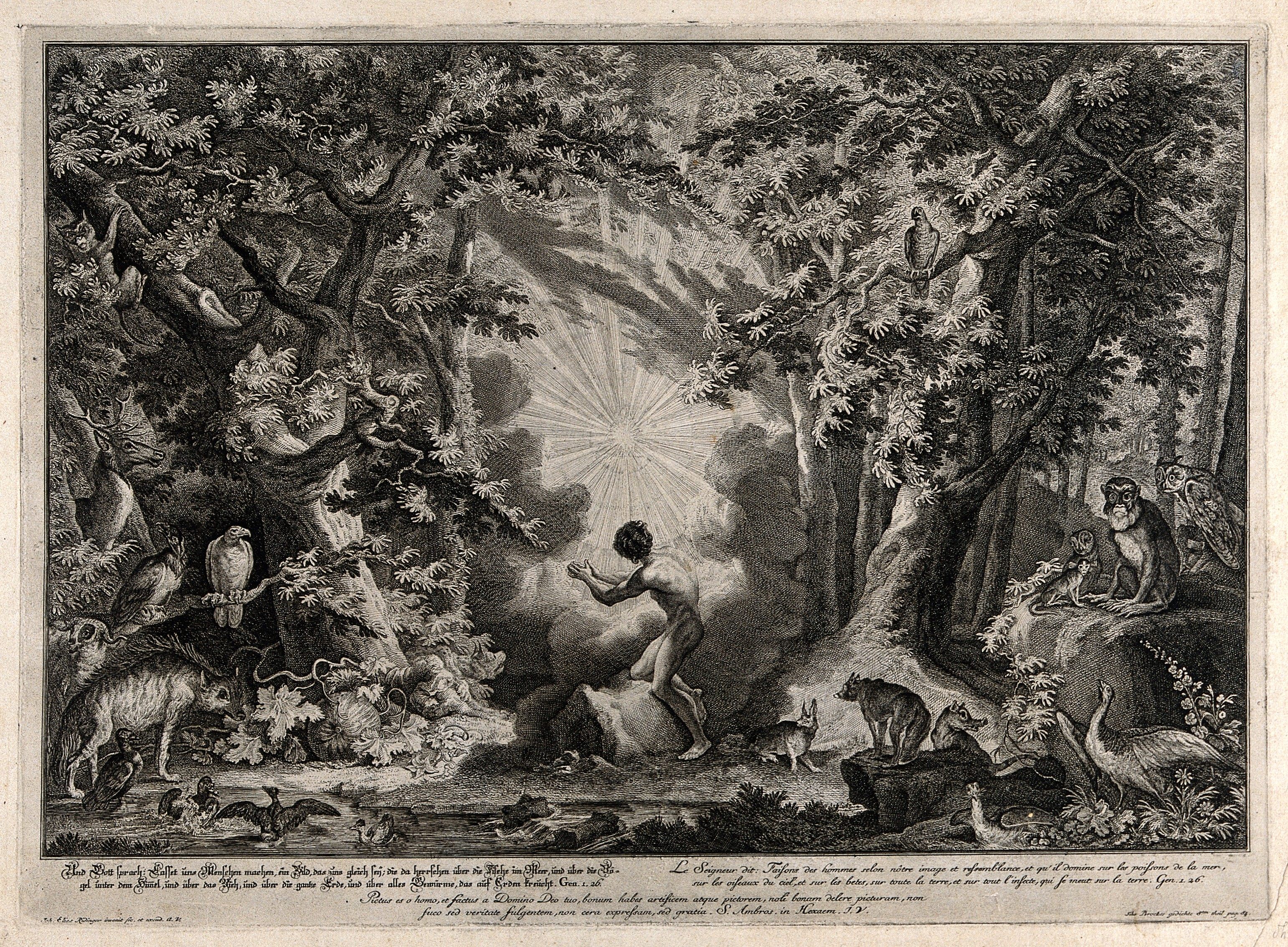
“A blinding light descends on Eden in the creation of man and the animals”: an etching of the Garden of Eden from J.E. Ridinger, c. 1750. (Photo: Wellcome Images, London/CC BY 4.0)
Marsh Eden
The tree of knowledge, at least the one in the southern Iraqi village of Qurna, is leafless with long twisted branches and its trunk is encased in a shrine. Next to it, a sign reads: “On this holy spot where Tigris meet Euphrates this Holy Tree of our Father Adam grew symbolising the Garden of Eden on Earth. Abraham prayed here 2000 years BC.”
In 1914, the British tried to seize control of the city of Basra, and Qurna was one of the first conquered villages. British military commanders called it the “Garden of Hell.” According to Brook Wilensky-Lanford’s book Paradise Lust: Searching for the Garden of Eden, British riverboat captains, perhaps under the influence of alcohol, climbed Qurna’s tree of knowledge in 1919, but ended up cracking it in half. It had been dead for so long that it could not support their weight. Locals were furious, and nearly lynched them, but it later came out that the revered tree had only been planted a century or two before. By 1946, the Times of London reported that local authorities had planted a new one.
Archaeologist Juris Zarins, a Garden of Eden expert, places the location of Eden not in Qurna, but 200 miles south of the ancient Mesopotamian city of Sumer, an area now under the waters of the Persian Gulf. In his theory, the biblical Gihon River corresponds with the Iran’s Karun River, and the mysterious Pishon is the Wadi Batin river system, in Saudi Arabia. As for the story of Adam and Eve, Zarins sees it as an allegory about the shift from hunting and gathering to agriculture.
Perhaps the best-known Garden of Eden in Iraq is also the most broken. It’s just southeast of Qurna, in Iraq’s ancient marshlands. The area itself was destroyed by Saddam in 1991, in an act of revenge against the native Ma’dan people, who participated in a Shiite rebellion against his regime. Reeds were burned with napalm. Canals drained the marsh water into the Persian Gulf. Where any water remained, it was poisoned with cyanide. Almost half a million marsh dwellers were displaced or killed.
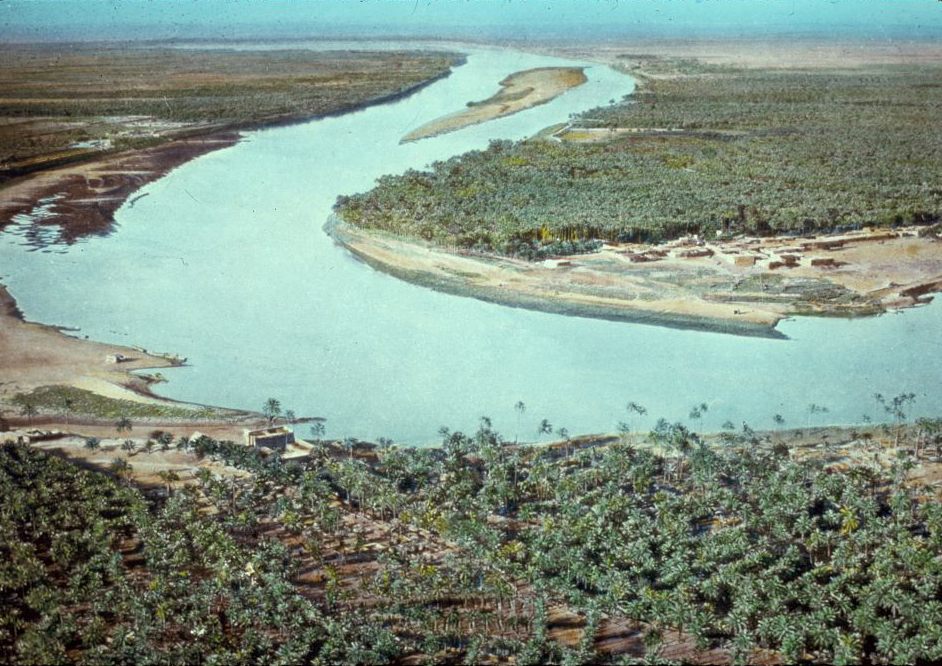
The Tigris River photographed from the air, c. 1950. (Photo: Library of Congress/LC-DIG-matpc-23032)
Since 2001, an Iraqi-American named Azaam Alwash, alongside a number of scientists and engineers, has been attempting to resurrect the marshes, a project called “Eden Again.” Alwash grew up in Iraq but left in 1978 to study civil engineering in America. He married, had children, became a U.S. citizen. Months after the American invasion, the 45-year-old father of two returned to Iraq to visit the marshlands. He learned of their destruction at the hands of Saddam but wanted to see for himself. It was impossible to imagine: in one of the largest ecosystems on the planet, miles of fresh water had turned to desert.
For months, Alwash lived in a hotel in Basra, conjuring up ways to use his skills as an engineer to rebuild this lost Eden. It was a place he’d visited as a child and he longed to see the area restored. The war was still going on and machine gunfire let loose outside his window.
As the marshes evaporated, they left huge salt deposits. As a first step, Eden Again participants reconnected the land to the rivers so that just enough water would seep through to flush out the salt deposits. This took many years. As the riverbanks overflowed, nutrient rich sediments deposited in the marshlands and created the basis for new growth.
In 2015, Alwash flew over the marshes in a helicopter with the Illinois National Guard’s 106th Aviation Wing. The canals dug by Saddam’s troops twisted below. For a while, there was nothing but desert, but this broke to blue water blooming with reeds. That day Alwash entered the marsh by boat. The reeds grew high over his head, and when the stalks parted, he discovered that a family of Ma’dan had returned, building an island of reeds, living as they always had.

A room in a Yazidi refugee home in Dohuk. (Photo: Erin Trieb)
Leaving Eden
I took a flight home out of Erbil, and on the ascent the plane started a controlled spiral, making big looping circles, gaining elevation until we were too high to target. It’s what the pilots do when they’re worried about missiles. There was no announcement; there was only Mosul, thousands of feet below, silent and the color of clay. We leveled and headed north, flying over Mt. Sinjar where ISIS massacred Yazidis.
Across the Turkish border, mountains piled atop each other, some barely powdered with snow. These were the Zagros Mountains, with their hidden blue lakes. In the distance I saw Mount Ararat, where the ark is said to have found rest when the floodwaters receded on the 17th day of the 17th month. These mountains are home to the headwaters of the Tigris and Euphrates, and some of the Assyrians believed their paradise spread this far.
This Islamic State, though, believes Noah’s Ark rested on Mt. Judi, a smaller mountain at the crossroads of Turkey, Iraq and Syria, and not on Mt. Ararat. Whichever mountaintop it was, the place where the ark rested is referred to as “the place of descent,” and “descent” is a word that makes a lot of sense when thinking about Eden. Mythology is far more urgent for individuals in a time of war–when society sinks to chaos, it so happens that Eden is often found.
We aren’t supposed to go back to Eden, but we keep trying. ISIS has named the desert town of Dabiq, in Syria, as the staging ground for the apocalypse and the location of the final battle, as laid out in the Quran, that will usher jihadists into their own Eden.





















Follow us on Twitter to get the latest on the world's hidden wonders.
Like us on Facebook to get the latest on the world's hidden wonders.
Follow us on Twitter Like us on Facebook